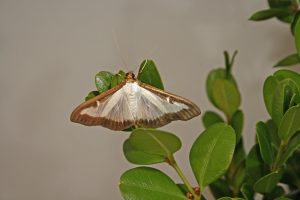DOVER, Del. (July 15, 2024) — The United States Department of Agriculture’s Animal and Plant Health Inspection Service (USDA-APHIS) has confirmed a find of box tree moth (BTM; Cydalima perspectalis) at a private residence in Kent County, Delaware.
The box tree moth is a federally regulated pest that primarily feeds on boxwood species (Buxus spp.). If left unchecked, it causes significant damage and can potentially kill the plants. Boxwoods are a popular ornamental evergreen shrub common to many landscape environments in the United States.
“Box tree moth is an unexpected find in Delaware due to the distance from the only known U.S. detections in New York, Michigan, Ohio, and Massachusetts, with the original introduction in New York in 2021. We are working closely with USDA and University of Delaware Extension to map out the infestations. Still, at this time, only one property in Kent County has a confirmed population and control measures have been implemented,” said Jessica Munski, Delaware Department of Agriculture’s Plant Industries Administrator. “This invasive pest is a good flyer, spreading naturally three to six miles a year, but it is suspected that they can fly up to 20 miles. The aggressive, destructive nature of the caterpillar life stage makes it essential to take quick action as soon as damage is detected because defoliation can occur within ten days.”
The caterpillars, which can grow to 1.5 inches, will start out as lime-green, with black stripes, white spots, hair, and a shiny black head. They then create a large amount of webbing on the plant. The caterpillars are ravenous feeders and, in heavy infestations, can completely defoliate host plants. After the leaves are gone, they feed on the bark, eventually killing the plant.

USDA photo by Hannah Nadel
The adult box tree moth generally has white wings with a thick brown border. It can be hard to find as it is most active at night. The BTM can sometimes be confused with the melonworm moth.
What You Can Do
Delawareans can help prevent this invasive pest from spreading throughout the state’s landscape, by monitoring, reporting, and controlling infestations.
- If you have boxwoods in your landscape, monitor your shrubs for brown or skeletonized leaves, defoliation, and webbing with caterpillars.
- Contact Delaware Cooperative Extension Master Gardeners at the Garden Helpline to report a suspected find and learn what pest management tools are available:
- New Castle County: 302-831-8862
- Kent County: 302-730-4000
- Sussex County: 302-831-3389
- Allow Delaware or Federal agricultural officials to inspect your boxwood plants and place detection traps.
- Remove infested boxwood plant branches. For heavy infestations, cut the boxwood from its base. Your plant should grow back from its roots. All boxwood debris should be double-bagged in plastic and placed in the trash. Homeowners should follow the Delaware Cooperative Extension’s pesticide recommendations.
- Nursery owners should monitor their boxwoods and implement safeguards to limit pest risk. All nursery businesses should report box tree moth detections to the Delaware Department of Agriculture at DDA_PlantPests@delaware.gov.
Learn more about the box tree moth at https://www.aphis.usda.gov/plant-pests-diseases/box-tree-moth.
###